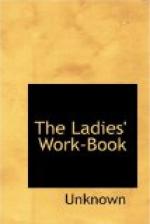EDGED VENETIAN BARS (No. 5). This is a Venetian bar, like the last, edged with Brussels or Venetian edging. This, with various other bars, frequently forms the groundwork of the guipured lace.
ENGLISH BARS (No. 7). These are frequently worked between two lines of Brussels or Venetian edging to connect them. They are made by passing the needle backwards and forwards through two opposite stitches, always tacking the under side of each, so that the threads be across the space smoothly and evenly. About four times each way will be sufficient. They are usually done across between two stitches, and then one at each edge is missed before the next bar is made. Sometimes these bars are radiated, a single stitch of the edge being missed on one side, and two at the other.
SORRENTO BARS (No. 8). These are bars which occur most frequently in Italian lace. They are simply twisted threads, so closely entwined that they only appear as one. They also are frequently radiated, and crossed; the effect produced will be seen in the accompanying diagram.
DOTTED VENETIAN BARS (No. 9). A bar of threads is made, as for a common Venetian bar. Do on it six stitches, and instead of drawing the seventh tight, hold the top by sticking a needle through it and the paper, about the tenth of an inch, and work on the threads of the loop three button-hole stitches. Do six more on the bar, and repeat.
[Illustration: VENETIAN EDGING.]
[Illustration: VENETIAN BARS.]
[Illustration: EDGED VENETIAN BARS.]
[Illustration: SORRENTO BARS.]
RALEIGH BARS (No. 10). Make a bar of threads, as for Venetian bars, and work on it about eight stitches. At the ninth, instead of bringing up the needle through the loop to form another button-hole, slip it under the bar, and bring it up on the right-hand side, leaving a loop of thread about two inches long, which you will hold down with your thumb, to keep it in its place. Now twist your needle six times under the right hand thread of this loop; draw it up, when it will make a knot, and slip the needle through it, above the bar, to continue the process. It may be observed that when this bar forms a part of the foundation of a piece of point, only two of these dots are generally seen on it, and they are placed near each other, almost in the centre of the bar.
POINT D’ALENCON (No. 11). This is only common herring-bone stitch, with the needle twisted once or oftener under the thread of each stitch, according as the space to be filled is narrow or wide.
SPANISH POINT (No. 12). This is the raised stitch which gives the peculiarly rich appearance to all the Spanish lace. A certain thickness of soft cotton is tacked down on the lace, in the form desired, and this is covered closely with button-hole stitch, edged with Raleigh dots, or with small loops. It is to be noticed that this is not attached to the lace by the button-hole stitches, but only by the thread which tacks down the soft cotton, so that it can be picked off without injury. The button-hole stitches must be worked very smoothly, and quite close together.




